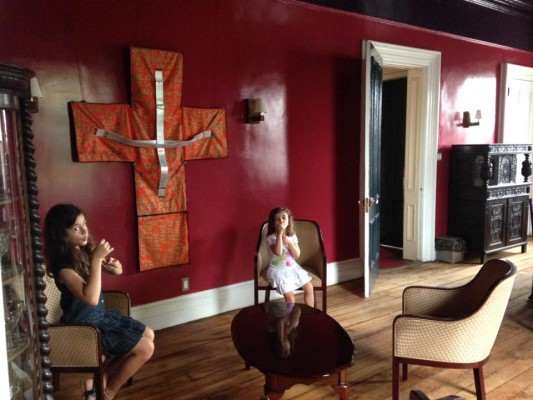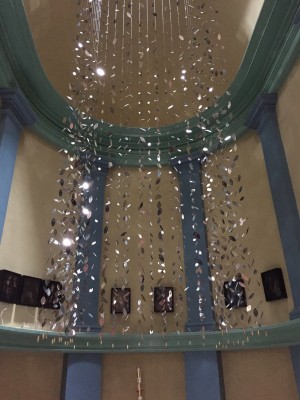There's a palpable experience of disorientation when you visit the rectory of St. Mary Grand on the Lower East Side of New York City. The address, 28 Attorney Street, is off the grid. You can’t drive on it (unless you drive a Fiat or a Vespa or a tractor), and you can’t find it on a map. It’s Old New York and it’s old and it’s New York.
Outside you feel small and invisible amidst high-rise apartment buildings and housing projects. Smells of food, drink, restaurants, street carts and trash; noise from construction projects, noise from traffic, noise from people; and people -- lots and lots of people: Chinese, Hispanic, homeless, gay, Hasidic.
It was said of St. Philip Neri that he wished to save people through the world, not from it. But in our social media-fixated, automobile-oriented, single-family and fenced-in suburban home, 3,000-plus family parish existence, how do we even find our way back into the world to begin with?
Here on Grand Street, the raw material of the world through which we are saved overflows like the upscale bars around the corner on Ludlow. Life throbs with an unsettling immediacy, oozing like the traffic down the Williamsburg Bridge onto Delancey. The effects of original sin are laid bare everywhere you look.
What does it mean when a visit here leaves me not with an urge to get out, but a longing to stay put? Amidst this chaos a parish that has been downtrodden for decades brims with hope and energy. Signs of renewal and growth abound: tiles on twin steeples of the 150-year-old church are being replaced with copper, the bell from 1876 has been repaired, and a renovated church hall sports exposed original stonework, space for hundreds and the construction of a tile mosaic of the Annunciation.
 At play in St. Mary Grand's dining room. Photo courtesy Jacqueline O'Connor 2016, All Rights Reserved
At play in St. Mary Grand's dining room. Photo courtesy Jacqueline O'Connor 2016, All Rights Reserved
Scores of long-time parishioners look at me knowingly, and I confirm what is already quite obvious to them, “I’m Fr. Andrew’s brother.” One man tells me God’s two gifts to the parish are Pope Francis and Fr. Andrew. We have just finished Sunday Mass, during which my brother blessed his sculpture, “Falling Leaves.” The day before, we celebrated a memorial Mass for our parents, which the parish hosted, and afterwards enjoyed a pig roast (four of us had been up since before six firing up the caja china).
In his Sunday homily on the Feast of the Holy Trinity, Andrew describes his many visits to the Sistine Chapel, and reflects on Michelangelo’s figure of the Sybil of Kumei, going off a long digression that circles back miraculously to a deep, deep theological insight: that the only person who knows what to ask of God is God Himself. Hispanic boys from working-class families, wearing dark baggy jeans and sporting close-cropped haircuts, stare at this really strange white guy.
On the sidewalk out front, an adorable nine-year old girl with dimples and long hair waits for the rest of her family. “Who’s your favorite priest?” I ask. “Fr. Andrew,” she says. “Do you know what my kids call him?” She shakes her head and flashes dimples. “Fr. Uncle Andrew.” Her eyes pop in amazement.
 Falling Leaves sculpture, based on Portia's 'Gentle rain of mercy,' Photo courtesy Andrew O'Connor 2016, All Rights Reserved
Falling Leaves sculpture, based on Portia's 'Gentle rain of mercy,' Photo courtesy Andrew O'Connor 2016, All Rights Reserved
The weekend is filled with stimulating conversation with people from all over New York, all over the country, all over the world. It’s filled with pig roasts and working-class Hispanics reading Shakespeare and sculpture and poetry. It’s filled with a tractor-ride to pick up beer, and honey harvested on the roof, and a chicken-coop and copper sinks and Morning Office in English, French and Latin.
There is nothing, I mean nothing, sterile or cookie-cutter about this parish; no resting on laurels or making excuses. There’s an everyday belief that God calls us to holiness, to live our life as saints: saints like Philip Neri, who taught poor begging women to use mental prayer. Cardinals hung about his room.
[Tweet "Don’t save people from the world. Save them through it."]
Don’t save people from the world. Save them through it. That’s what God made it for! Pope Francis’ message? Get out and go into the world, because where so many of us are, isn’t the world. Fr. Andrew’s message? The world is a great place to be. Come see what you’ve been missing. We could use your help.
Copyright 2016 Kiernan O'Connor
About the Author

Guest
We welcome guest contributors who graciously volunteer their writing for our readers. Please support our guest writers by visiting their sites, purchasing their work, and leaving comments to thank them for sharing their gifts here on CatholicMom.com. To inquire about serving as a guest contributor, contact editor@CatholicMom.com.


.png?width=1806&height=731&name=CatholicMom_hcfm_logo1_pos_871c_2728c%20(002).png)
Comments